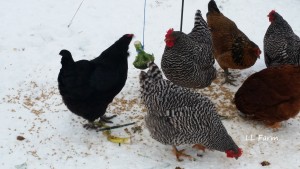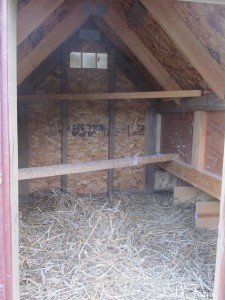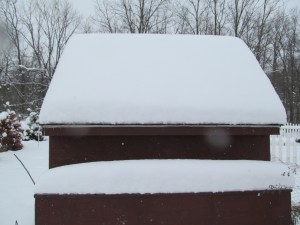Old man winter will be knocking on our doors soon, so I thought this would be a good time to review some winter strategies for keeping chickens safe and healthy during cold weather. A winter check list for your chickens…
Your chickens have probably finished molting by now, or should be soon. Their new feathers will help them maintain the correct body temperature as the outside temperature decreases. A heat source is not necessary, unless you have a delicate breed of poultry.
Water is always important for your flock. During the winter, it is crucial that their water is not frozen. Keeping Chickens Through The Winter reviews some reasons as to why I prefer plastic water containers for the colder months.
Food. Sometimes I also supplement their layer food with kitchen scraps. Lettuce, broccoli, and kale are winter favorites for my ladies, providing extra nourishment. I don’t put food inside the coop, which can attract rodents. Being outside (even in the cold weather) is good for your flock.

You can toss the scraps into the chicken yard or hang them for the chickens to peck at. Hanging treats is a great alternative to pecking and scratching the ground (that may be buried under cold snow).

Ventilation is crucial to your flock’s health. For all seasons, including winter, it is important to have a well ventilated coop. Inevitably, chicken poo causes moisture inside the coop. A well ventilated coop will allow the moist air to flow out. If your coop is airtight, the droppings will start to compost and create an ammonia smell, which can cause respiratory illness in your flock. Too much moisture in the coop can also lead to frostbite; a reason I don’t put their water inside the coop. Ventilation also allows necessary fresh air to circulate.

Dust bathing is natural for chickens. It is their way of keeping clean and to fend off parasites. During the winter when the ground is frozen or covered in snow, you can create a dust bath for your flock, using wood ash.

Outside roosting areas are great for chickens year round, but during the winter it provides an area for them to get off the snow, without going inside the coop . Tree branches and logs are a great source to use, or you can use scrap materials to quickly build one.

Straw can be used on the outside of your coop for insulation. Strategically placed under the nesting area of the coop can help keep eggs from freezing.

Interestingly, packed snow can also act as an insulator.
Straw is a great choice for inside the coop also. Chickens will naturally peck, moving the straw around. Straw and the pockets between the straw can help maintain a pleasant temperature inside the coop for your chickens.
Deep Litter Method. Within the last year, I have been using the deep litter method all year round, cleaning the coop only as necessary. Not only does the deep litter method help create compost, but the thicker layer of straw can also help insulate the coop.
Along with these few check list items, it is also important to check your coop for gaps and holes. Closing them up will help keep the cold (and rodents) out.
Peek in on your flock in the evening before you close them in. Rest assured, they will be roosting side by side, helping to keep each other warm. Happy chicken keeping in the winter!












